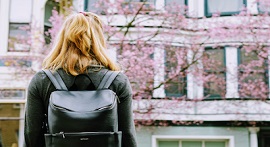Academics
With the “nation’s capital in its backyard,” George Mason University in Fairfax, Virginia offers “strong academics” combined with proximity to a bustling center of industry and innovation. Mason prepares its students to enter by offering a “large variety of academic programs” and providing a solid infrastructure that is “constantly growing” and “providing many excellent opportunities for students,” including research opportunities for undergraduates. The “humanities and economics draw on the local Washington D.C. talent” “and the engineering school has an “advanced” IT program that “Is developed with concentrations in information security, healthcare, networking, and more.” Students note that “jobs in all the fields that Mason provides are just within a 10-mile radius of campus,” including “top tech companies,” which “come to Mason because there is a huge Mason alumni community in the Northern Virginia area.” One grateful student notes “it was easy to transfer to with NOVA’s Pathway Program” because they had an “easy outline of what classes I needed to take at NOVA to transfer over and pursue a certain degree.”
Student Body
This is one school where “diversity” is truly an accurate term in all its breadth. Students choose Mason for this wide representation of culture and experience. “As a first-generation student of color,” one student says, “I think representation is integral to creating a sense of belonging. Because I could see myself reflected in the students, I chose Mason because I knew that I wouldn’t be othered or feel like I was the minority.” There is a “large population of immigrant-heritage students, international students, and students from almost every state in the United States.” and the “littlest differences like different name spellings, accents, dress, and more importantly, different political ideas and perspectives are respected and acknowledged, and even more so, celebrated here at Mason.” While there are “many students who entered straight from high school...there are also many students who are already working and are returning to school as well as many international students.” The “campus keeps growing, housing over 6,000 residents,”—of the 37,000 or so total students. “Due to the enormous and intimidating physical size of GMU, the school offers many ways for students to feel included and engage themselves in extracurricular activities should they choose to do so,” one student offers.
Campus Life
With Washington, D.C. just “a metro ride away,” “the majority of students at Mason are commuters,” meaning “many of them are not very involved.” Even in the “closeknit layout of the main campus,” in fact, even for on-campus residents, most campus life happens off campus, including the partying, since fraternities are off-campus. There are many social clubs and organizations, however, with “most students taking part in several.” Examples include the “acapella group” and “swing dancing.” Many also “meet to practice for competitions, including the Indian dance troupe.” Mason has a “free shuttle bus that takes students to the metro” for activities in D.C. The Johnson Center is another “major place that students spend time: there is a food court, a library, meeting rooms, kiosks, the cinema, and huge study areas.” Students will also “go to one of the three gyms on campus and work out, a lot of people bike around campus.”




